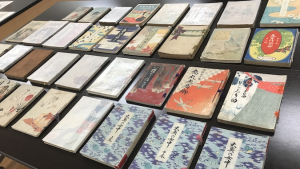
Kuchi-e prints are a distinctive genre of Japanese woodblock illustrations that were inserted inside of popular literary magazines during the Meiji and Taishō periods, reflecting the rich cultural landscape of late 19th and early 20th-century Japan. The University of Hawaiʻi at Mānoa Library has recently acquired a unique collection of more than 200 Kuchi-e prints, generously donated by Nanako Yamada, a scholar and collector based in Honolulu.

The Yamada Collection showcases works by renowned ukiyo-e artists such as Hanko Kajita and Toshikata Mizumo, who used traditional techniques to produce stunning frontispieces for early modern magazines, most notably Bungei Kurabu.
An avid collector, Yamada is the author of nine books on Kuchi-e, including Woodblock Kuchi-e Prints: Reflections of Meiji Culture.
Finding a new home
In addition to the woodblock prints, Yamada has also donated dozens of accompanying literary magazines, particularly issues of Bungei Kurabu. These magazines were designed to attract readers, especially women and young adults, with the Kuchi-e illustrations serving as a captivating intersection between visual art and modern Japanese literary history.

“The images by some of the most talented artists of the Meiji-Taishō period, representing iconic scenes in magazine-serialized novels, functioned to draw readers into the tales and fuel their imaginations,” explained Andre Haag, professor of Japanese literature at UH Mānoa.
The Yamada Collection also highlights the meticulous technique of inserting frontispieces into each novella, which has broader implications for fields such as bookbinding and museum studies. Graduate students across the departments of the College of Arts, Languages & Letters will be able to utilize the collection as a new resource for their research this fall.
After considering various possible homes for her rare and unique collection, Yamada chose UH Mānoa Library due to the expertise and dedication of Mitsutaka “Mitsu” Nakamura, Japan studies librarian, and Sachiyo Kawaiʻaeʻa, Japanese cataloger.
“The research value of these prints is immense,” said John Szostak, professor and Japanese art historian at UH Mānoa. “Ms. Yamada did an excellent job in gathering prints by prominent artists and kept them in wonderful condition.”
Plans for digitization, public display

Plans to digitize the Kuchi-e collection are currently being explored through grant opportunities aiming to make the collection accessible to a wider audience. Nakamura was recently awarded the 2024 Karl Lo Award and will receive $7,000 from the Pacific Rim Research Libraries Alliance to assist with the digitization project.
In the near future, the collection will also be exhibited in the library’s galleries for the public to visit.
The Yamada Collection is housed in Hamilton Library’s Asia Collection. Request a research appointment to view the collection.

